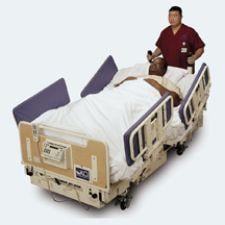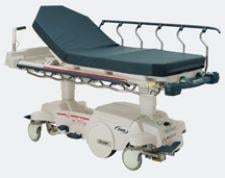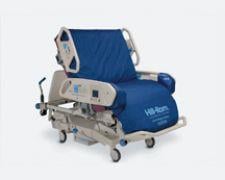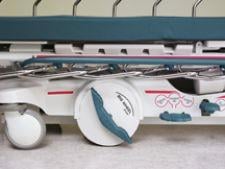
Stryker Medical's Zoom
Only a marketing director for stretchers could draw a parallel between a nurse and an auto mechanic.
“Have you ever watched somebody push a stretcher?” asked Don Payerle from Stryker Medical. “They lean into it — kind of like getting an old Chevy going. Once it rolls, it's not nearly as hard to keep going, but the first steps are where they really have to put their backs into it.”
Terri Brunswick, an occupational healthcare practitioner at Evergreen Healthcare (Kirkland, WA), has a lot to say about that first step and the grief it's caused her hospital's employees over the years. Muscular and skeletal sprains and strains are some of the most common injuries she can name off the top of her head.
“Back injuries are the worst — that's my highest rate,” she said. “I had an employee come in just a few minutes ago after pushing a piece of equipment, and she said she just ‘felt something' that wasn't right.”
But she admits that at least it's not as bad as it used to be. Between 2004 and 2006 the hospital’s injury rate in transporting patients was reduced by 98 percent — thanks to new safety procedures backed by Washington's Safe Patient Handling law passed last March and a partnership with Stryker.
“I was getting lots of complaints from employees who were pushing stretchers with patients on them down halls with carpeting and it was very difficult,” Brunswick said. “So we've been looking at safe patient handling for several years now. The bill that was passed just gave us some backbone to what we were asking for all along.”
The new law protects Washington healthcare workers against injury related to manual patient lifting through the use of modern technology designed for the task. A similar law was passed last year in Texas, and bills have recently been introduced in New Jersey, Illinois and Florida.
The stronger focus on ergonomics is changing the patient transport market, according to Payerle.
“From our perspective, people are investing in better mobility devices because nurses are getting older and more in demand, and hospitals and states are mandating devices to make sure a nurse's life is easier,” he said.
The Invention of the Wheel —
And Then Some
Stryker's answer to the trend was in the form of a big wheel.
“That is where the big bang for your buck comes in — that big wheel,” Payerle said. The company tinkered with its original stretcher a few years ago and found that by adding a giant wheel to the front, less effort is used to push it forward. He says the Big Wheel stretcher is much like carts used at hardware stores.
“You know those carts that have the small wheels on the corners and the larger wheel in the middle?” he said. “It's based on that concept. The difference is we offset the wheel so it matches where the bulk of the patient's weight is, so it keeps it sturdy and it doesn't teeter-totter back and forth all the time.”
This also solves the second most common reason for patient transfer-related injuries, Payerle said — the twisting motion that goes into play when a healthcare worker is steering a patient.
A few years after the Big Wheel, the company added a motor to the stretcher, making it even easier to start (although a bit more expensive — around $10,000 each, according to Brunswick). It's called the Zoom.
“We take the same exact Big Wheel design and power that big wheel so it gives us tremendous traction… all the nurse has to do is guide the stretcher,” Payerle said.
Evergreen started out with two Zoom stretchers in 2004, and Brunswick says it didn't take long for the staff to get used to them.
“I think they were just a little scared of it at first because they weren't sure about how much control they had,” she said. “You are very much in control, but it took a little practice for the staff to learn that.”
Now Evergreen is equipped with 15 Zoom stretchers and Brunswick says her staff is “loving it” — even stealing them from other departments within the hospital.
“It's set up with really good safety features,” she said. “If you're moving along and something happens and your patient starts to move off the stretcher, you just let go of the handle and it stops immediately.”
She also said it’s helpful from an ergonomic standpoint.
“One of the things that nurses do a lot is sit a patient up,” Brunswick said. “That is a very difficult act and very hard on the nurse’s back. The Zoom is hydraulic so you basically are just guiding the head of the stretcher up.”
The Motorized Revolution
Bruce Allen, marketing director for Kinetic Concepts Inc. (KCI), believes the future of patient transport lies in motorized equipment.
KCI's new BariMAXX II Power Drive System was built with that concept in mind — it's a powered bed with a motored wheel at the base and control handles at the top.
“A majority of injuries to nurses are to the back, and that is primarily the cause of overexertion or patient handling,” he said.
The BariMAXX II has reverse, forward and fast forward speeds as well as a horn and an accelerated switch. The BariAir is another KCI product that Allen says aims to prevent injuries on the job.
“The BariAir and BariKare have stable patient handles for patients to hold on to when they are getting out of bed,” he said. “There are air surfaces that have a turning feature that help nurses turn patients so they don't have to physically do it themselves.”
Hill-Rom's new Total Care line consists of the CareAssist bed for low acuity patients, VersaCare for medium acuity and TotalCare for higher acuity patients. Each line has progressively more features that support caregiver and patient safety.
With the addition of the IntelliDrive system, the beds can be pushed around by motor. And much like the BariMaxx II, it eliminates the need to transfer patients to stretchers for transport.
“The motor is becoming an expectation in the market,” Allen said. “People manually pushing around beds are just not seen as much anymore. You are starting to see motors on stretchers, stretch chairs and bariatric chairs that convert from a chair to a stretcher.”



